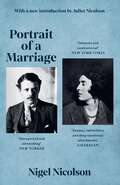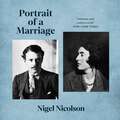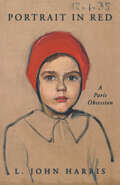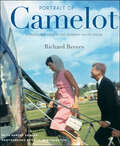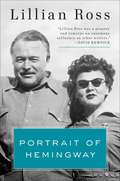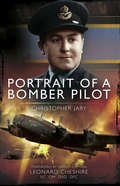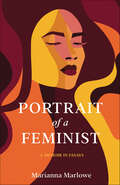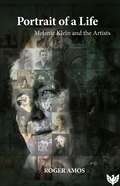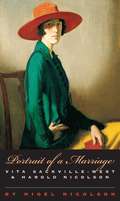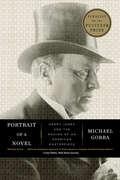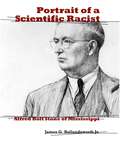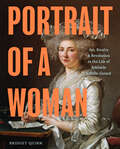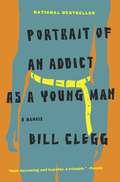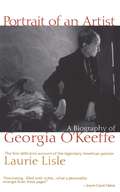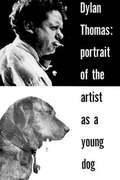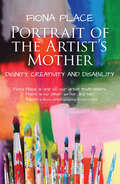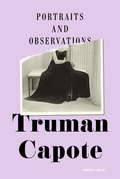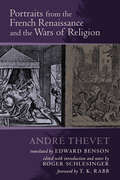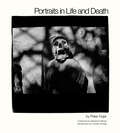- Table View
- List View
Portrait Of A Marriage: Vita Sackville-West and Harold Nicolson
by Vita Sackville-West Nigel Nicolson MBEThe fascinating story of an unconventional, bisexual and powerfully loving relationship and a unique portrait of gender and feminism - with a new introduction from Juliet Nicolson.'A brilliantly structured account of the dramas, infidelities and deep emotional attachments' GUARDIAN'An intimate and controversial account of his bisexual parents' open relationship' NEW YORK TIMES'One of the most absorbing stories, built around two very remarkable people, ever to stray from Gothic fiction into real life' TLSThe marriage was that between the two writers, Vita Sackville-West and Harold Nicolson and the portrait is drawn partly by Vita herself in an autobiography which she left behind at her death in 1962 and partly by her son, Nigel. It was one of the happiest and strangest marriages there has ever been. Both Vita and Harold were always in love with other people and each gave the other full liberty 'without enquiry or reproach', knowing that their love for each other would be unaffected and even strengthened by the crises which it survived. This account of their love story is now a modern classic.
Portrait Of A Marriage: Vita Sackville-West and Harold Nicolson
by Vita Sackville-West Nigel Nicolson MBEThe fascinating story of an unconventional, bisexual and powerfully loving relationship and a unique portrait of gender and feminism - with a new introduction from Juliet Nicolson.'A brilliantly structured account of the dramas, infidelities and deep emotional attachments' GUARDIAN'An intimate and controversial account of his bisexual parents' open relationship' NEW YORK TIMES'One of the most absorbing stories, built around two very remarkable people, ever to stray from Gothic fiction into real life' TLSThe marriage was that between the two writers, Vita Sackville-West and Harold Nicolson and the portrait is drawn partly by Vita herself in an autobiography which she left behind at her death in 1962 and partly by her son, Nigel. It was one of the happiest and strangest marriages there has ever been. Both Vita and Harold were always in love with other people and each gave the other full liberty 'without enquiry or reproach', knowing that their love for each other would be unaffected and even strengthened by the crises which it survived. This account of their love story is now a modern classic.
Portrait Of A Marriage: Vita Sackville-West and Harold Nicolson
by Vita Sackville-West Nigel Nicolson MBEThe fascinating story of an unconventional, bisexual and powerfully loving relationship and a unique portrait of gender and feminism - with a new introduction from Juliet Nicolson.'A brilliantly structured account of the dramas, infidelities and deep emotional attachments' GUARDIAN'An intimate and controversial account of his bisexual parents' open relationship' NEW YORK TIMES'One of the most absorbing stories, built around two very remarkable people, ever to stray from Gothic fiction into real life' TLSThe marriage was that between the two writers, Vita Sackville-West and Harold Nicolson and the portrait is drawn partly by Vita herself in an autobiography which she left behind at her death in 1962 and partly by her son, Nigel. It was one of the happiest and strangest marriages there has ever been. Both Vita and Harold were always in love with other people and each gave the other full liberty 'without enquiry or reproach', knowing that their love for each other would be unaffected and even strengthened by the crises which it survived. This account of their love story is now a modern classic.
Portrait in Red: A Paris Obsession
by L. John HarrisThe quest to uncover the history of a mysterious painting, and a joyous exploration of art in the twentieth century and beyond.While wandering the streets of Paris in 2015, L. John Harris finds an abandoned, unfinished, and strangely compelling painting. The subject: a girl wearing a bright-red head covering, fixing her viewer with a foreboding gaze. The painting bears no signature, only the date: January 12, 1935. Harris, a journalist and illustrator, embarks on a multi-year quest to uncover the story behind this painting. His sleuthing has given birth to Portrait in Red, a wide-ranging exploration of art and its enduring mysteries.With wit and a contagious enthusiasm, Harris traces unexpected connections between Paris on the eve of World War II, his bohemian life in the San Francisco Bay Area, the aura of original paintings, the magic of found objects, and the aesthetics of a perfect croque monsieur. Portrait in Red will delight lovers of Edmund de Waal's The Hare with Amber Eyes or Michael Finkel's The Art Thief. By turns heartbreaking and laugh-out-loud funny, it is an existential detective story, set among world tragedies, art-historical epiphanies, and comic hijinks.
Portrait of Camelot: A Thousand Days in the Kennedy White House
by Richard Reeves Harvey SawlerA revealing and intimate portrait of a president, husband, and father as seen through the lens of the first official White House photographer. Cecil Stoughton’s close rapport with President John F. Kennedy and First Lady Jacqueline Kennedy gave him extraordinary access to the Oval Office, the Kennedys’ private quarters and homes, state dinners, cabinet meetings, diplomatic trips, and family holidays. Drawing on Stoughton’s unparalleled body of photographs, most rarely or never before reproduced, and supported by a deeply thoughtful narrative by political historian Richard Reeves, Portrait of Camelot is an unprecedented portrayal of the power, politics, and warmly personal aspects of Camelot’s 1,036 days.“Reveals an intimate account of a very public figure…the rare archive of images features the president during state dinners and cabinet meetings at the White House to family holidays and vacations at their private homes.” —Vanity Fair
Portrait of Hemingway (Modern Library Anthologies Ser.)
by Lillian RossThe definitive sketch of one of America's greatest writers.On May 13, 1950, Lillian Ross's first portrait of Ernest Hemingway was published in The New Yorker. It was an account of two days Hemingway spent in New York in 1949 on his way from Havana to Europe. This candid and affectionate profile was tremendously controversial at the time, to the great surprise of its author. Booklist said, "The piece immediately conveys to the reader the kind of man Hemingway was--hard-hitting, warm, and exuberantly alive." It remains the classic eyewitness account of the legendary writer, and it is reproduced here with the preface Lillian Ross prepared for an edition of Portrait in 1961. Ernest Hemingway was born on July 21, 1899, and to celebrate the centenary of this event, Ms. Ross wrote a second portrait of Hemingway for The New Yorker, detailing the friendship the two struck up after the completion of the first piece. It is included here in an amended form.
Portrait of a Bomber Pilot
by Christopher JaryDuring the Second World War RAF Bomber Command produced a handful of remarkable pilots who won fame and high honors: Gibson, Cheshire, Martin, Tait, and Searby. The majority of aircrew, however, were young sergeants, many of whom did not survive to complete a first tour of thirty operations. Between the two extremes, there were, on every squadron, one or two senior captains who had survived one tour and whose experience, skill, courage, and example made a vital contribution to their squadron's life, training and operational success. This book is about one such captain, Flight Lieutenant Jack Wetherly, DFC. It traces his development from novice second pilot of a Wellington in the pioneering days of 1940 to senior captain of a Halifax in Wing-Commander Leonard Cheshire's squadron in what MRAF Sir Arthur Harris called his 'Main Offensive'. It deals also with his pre-war life and service, flying tiny bi-planes with the RAFVR, and with his career as a flying instructor at the RAF College Cranwell and as an instructor of instructors at RAF Montrose.Above all, it is a personal book, inspired by the sacrifice made nearly half a century ago by a young man of twenty-eight. Acclaim for the work:''Reading Portrait of a Bomber Pilot, I felt that I was living with Jack Wetherly through the last few years of his young life. He is a good man to be with honorable, selfless, and an exceptional pilot...Christopher Jary has written of Jack Wetherly carefully, unsentimentally, and very movingly. He has added a chapter to the brave, sad story of World War Two''.
Portrait of a Feminist: A Memoir in Essays
by Marianna MarloweInfused with a passion for justice, this sublime, expansive memoir by a Peruvian American feminist will appeal to fans of Crying in H Mart and How to Raise a Feminist Son. Through braided memories that flash against the present day, Portrait of a Feminist depicts the evolution of Marianna Marlowe’s identity as a biracial and multicultural woman—from her childhood in California, Peru, and Ecuador to her adulthood as an academic, a wife, and a mother. How does the inner life of a feminist develop? How does a writer observe the world around her and kindle, from her earliest memories, a flame attuned to the unjust? With writing that is simultaneously wise and shimmering, nuanced and direct, Marlowe explores her own experiences with the hallmarks of patriarchy. Interweaving stories of life as the child of a Catholic Peruvian mother and an atheist American father in a family that lived many years abroad, she explores realities familiar to so many of us—unequal marriages, class structures, misogynist literature, and patriarchal religion. Portrait of a Feminist confronts the two most essential questions of feminism today: What does it look like to live a life in defense of feminism? And how should feminism be evolving today?
Portrait of a Life: Melanie Klein and the Artists
by Roger AmosMelanie Klein was a Viennese psychoanalyst who extended the work of Sigmund Freud in significant and innovative ways. She lived and worked in the UK from 1926 until her death in 1959. During her life she was a controversial and divisive figure and has remained so since her death; conflict between the Freudian and Kleinian strands of psychoanalysis dominated the history of psychoanalysis in the latter half of the twentieth century. The reasons why she polarised opinion are multiple and complex; partly they were related to her psychoanalytic ideas and how she expressed them but they were also intrinsic to her personality. In 2016, a pair of delicate low relief sculptures of Melanie Klein in profile were re-discovered, having been hidden away for some eighty years, and have been subsequently identified as the work of the sculptor Oscar Nemon. Roger Amos was asked to write a brief article about these sculptures for publication on the Melanie Klein Trust website. During his research, he discovered that Klein had destroyed two significant works of art depicting herself: one a bust by the same sculptor as the low relief profiles, Oscar Nemon, and the other a portrait by William Coldstream. This beautifully illustrated book is the first comprehensive review of all attempts to portray Klein during her lifetime, from her earliest childhood until her old age, including the work of painters, sculptors, and portrait photographers. It reviews the history of each artistic project and the relationship between Klein and the artist involved, locating them in a narrative of Klein's life. The complex and interrelated reasons why she chose to destroy some of the representations of herself but kept others are identified and discussed. Through an understanding of the subject/artist relationship, Amos illuminates Klein's professional life in the world of psychoanalysis. A must-read for all scholars and professionals working in the field of psychoanalysis, psychotherapy and psychodynamic counselling, plus those with an interest in Melanie Klein or aesthetics, this enjoyable read shines a never-before seen light on to the world of Melanie Klein.
Portrait of a Marriage: Vita Sackville-West and Harold Nicolson
by Nigel NicolsonVita Sackville-West, novelist, poet, and biographer, is best known as the friend of Virginia Woolf, who transformed her into an androgynous time-traveler in Orlando. The story of Sackville-West's marriage to Harold Nicolson is one of intrigue and bewilderment. In Portrait of a Marriage, their son Nigel combines his mother's memoir with his own explanations and what he learned from their many letters. Even during her various love affairs with women, Vita maintained a loving marriage with Harold. Portrait of a Marriage presents an often misunderstood but always fascinating couple. "Portrait of a Marriage is as close to a cry from the heart as anybody writing in English in our time has come, and it is a cry that, once heard, is not likely ever to be forgotten. ... Unexpected and astonishing."--Brendan Gill, New Yorker. "The charm of this book lies in the elegance of its narration, the taste with which their son has managed to convey the real, enduring quality of his parents' love for each other."--Doris Grumbach, New Republic
Portrait of a Novel: Henry James and the Making of an American Masterpiece
by Michael GorraA revelatory biography of the American master as told through the lens of his greatest novel. Henry James (1843-1916) has had many biographers, but Michael Gorra has taken an original approach to this great American progenitor of the modern novel, combining elements of biography, criticism, and travelogue in re-creating the dramatic backstory of James's masterpiece, Portrait of a Lady (1881). Gorra, an eminent literary critic, shows how this novel--the scandalous story of the expatriate American heiress Isabel Archer--came to be written in the first place. Traveling to Florence, Rome, Paris, and England, Gorra sheds new light on James's family, the European literary circles--George Eliot, Flaubert, Turgenev--in which James made his name, and the psychological forces that enabled him to create this most memorable of female protagonists. Appealing to readers of Menand's The Metaphysical Club and McCullough's The Greater Journey, Portrait of a Novel provides a brilliant account of the greatest American novel of expatriate life ever written. It becomes a piercing detective story on its own.
Portrait of a President
by William ManchesterAn up-close look at John F. Kennedy by one of his closest confidants, a New York Times–bestselling biographer. Written by a prize-winning historian and biographer of such giants as Winston S. Churchill and Douglas MacArthur, this intimately detailed account provides a rare personal glimpse into the emotions behind the Kennedy administration—from the elation of victory to the frustrating challenges facing a young president at a pivotal turning point in US history. Originally published in 1962—before the assassination of JFK—Portrait of a President is William Manchester&’s first biography of the thirty-fifth president of the United States. In addition to firsthand encounters with JFK, the biography draws from over forty interviews conducted in the first year of his presidency. In speaking with those closest to the commander-in-chief, both in his administration and his family, Manchester captures a complete portrait of one of the most highly regarded figures of the twentieth century. This edition includes a new introduction and epilogue written by Manchester in the aftermath of November 1963, adding to the mythos by documenting not just how President Kennedy lived, but also the legacy he left behind.
Portrait of a Scientific Racist: Alfred Holt Stone of Mississippi
by James G. Jr.In the years after Reconstruction, racial tension soared, as many white southerners worried about how to deal with the millions of free African Americans among them -- an issue they termed the "negro problem." In an attempt to maintain the status quo, white supremacists resurrected old proslavery arguments and sought new justification in scientific theories purporting to "prove" people of African descent inherently inferior to whites. In Portrait of a Scientific Racist James G. Hollandsworth, Jr., reveals how the conjectures of one of the country's most prominent racial theorists, Alfred Holt Stone, helped justify a repressive racial order that relegated African Americans to the margins of southern society in the early 1900s.In this revealing biography, Hollandsworth examines the thoughts and motives of this renowned man, focusing primarily on Stone's most intensive period of theorizing, from 1900 to 1910. A committed and vocal white supremacist, Stone believed black southern workers were inherently lazy, a trait he attributed to their African genes and heritage. He asserted that slavery helped improve the black race but that opportunities still existed during Reconstruction to mold the freedmen into efficient workers. Stone's central -- yet unspoken -- goal was to devise a way to maintain an obedient, productive labor force willing to work for low wages. Writing from both Washington, D.C., and his cotton plantation in the Mississippi Delta, Stone published numerous essays and collected more than 3000 articles and pamphlets on the "American Race Problem" -- including those written by bitter racists and enthusiastic "race boosters."Though Stone lacked the credentials typically associated with scholarly experts of the time, he became an authority on the subject of black Americans, in part because of his close friendship with fellow scientific racist and statistician Walter F. Willcox. An early member of the American Economic Association and other academic groups, Stone went on to serve as head scholar of a division for race studies within the Carnegie Foundation. Interestingly, Stone recruited W. E. B. Du Bois and Booker T. Washington to collaborate with him on a major study for the Foundation, continuing his tendency to incorporate all perspectives into his study of race.Hollandsworth uses Stone's extensive correspondence with Willcox, Du Bois, and Washington, as well as his personal writings -- both published and unpublished -- to reveal the secrets of this misguided, yet fascinating, figure.
Portrait of a Woman: Art, Rivalry, and Revolution in the Life of Adélaïde Labille-Guiard
by Bridget QuinnDiscover the story of Adélaïde Labille-Guiard—a long-ignored artist and feminist of eighteenth-century France—in this imaginative and illuminating biography from an award-winning writer.Born in Paris in 1749, Adélaïde Labille-Guiard rose from shopkeeper’s daughter to an official portraitist of the royal court—only to have her achievements reduced to ash by the French Revolution. While she defied societal barriers to become a member of the exclusive Académie Royale and a mentor for other ambitious women painters, she left behind few writings, and her legacy was long overshadowed by celebrated portraitist and memoirist Élisabeth Vigée-Lebrun.But Adélaïde Labille-Guiard’s story lives on. In this engaging biography, Bridget Quinn applies her insightful interpretation of art history to Labille-Guiard’s life. She offers a fascinating new perspective on the artist’s feminism, her sexuality, and her vision of the world. Quinn expertly blends close analyses of paintings with broader context about the era and inserts delicately fictionalized interpersonal scenes that fill the gaps in the historical record. This is a compelling and inspiring look at an artist too long overlooked.INSPIRING HISTORICAL NONFICTION: Despite numerous setbacks, Labille-Guiard built a legacy as an accomplished royal portraitist and a mentor to other young women artists of her era. This tale of solidarity, self-belief, and true passion for painting is sure to inspire contemporary creatives and women today. CREATIVE AND COMPELLING ART HISTORY BOOK: Bridget Quinn is an award-winning author and art historian who has spent years researching Adélaïde Labille-Guiard’s work and life. She vividly evokes both and weaves a compelling narrative at the intersection of art, gender, and politics. GORGEOUS ART REPRODUCTIONS THROUGHOUT: This biography features full-color images of artwork by Adélaïde Labille-Guiard, her rumored rival Élisabeth Vigée-Lebrun, and other artists of the era, including portraits of key players in the narrative. These images, interspersed throughout the book, offer valuable visual references to illuminate the engaging text even further.AN ARTFUL GIFT BOOK: Uniquely crafted and thoroughly researched, this volume makes an outstanding gift for art history enthusiasts and readers who love exploring untold stories in women's history.Perfect for:Readers of memoirs and biographiesHistory buffs and fans of historical fiction and nonfictionArtists, art lovers, museumgoers, and art history studentsFeminists and readers seeking feminist booksFrancophiles and those interested in the French RevolutionFans of Portrait of a Lady on Fire and other historical dramas
Portrait of an Addict as a Young Man: A Memoir
by Bill CleggBill Clegg had a thriving business as a literary agent, a supportive partner, trusting colleagues, and loving friends when he walked away from his world and embarked on a two-month crack binge. He had been released from rehab nine months earlier, and his relapse would cost him his home, his money, his career, and very nearly his life. What is it that leads an exceptional young mind want to disappear? Clegg makes stunningly clear the attraction of the drug that had him in its thrall, capturing in scene after scene the drama, tension, and paranoiac nightmare of a secret life--and the exhilarating bliss that came again and again until it was eclipsed almost entirely by doom. He also explores the shape of addiction, how its pattern--not its cause--can be traced to the past. Portrait of an Addict as a Young Man is an utterly compelling narrative--lyrical, irresistible, harsh, honest, and beautifully written--from which you simply cannot look away.
Portrait of an Artist: A Biography of Georgia O'keeffe
by Laurie LisleGeorgia O'Keeffe, one of the most original painters America has ever produced, left behind a remarkable legacy when she died at the age of ninety-eight. Her vivid visual vocabulary -- sensuous flowers, bleached bones against red sky and earth -- had a stunning, profound, and lasting influence on American art in this century. O'Keeffe's personal mystique is as intriguing and enduring as her bold, brilliant canvases. Here is the first full account of her exceptional life -- from her girlhood and early days as a controversial art teacher...to her discovery by the pioneering photographer of the New York avant-garde, Alfred Stieglitz...to her seclusion in the New Mexico desert, where she lived until her death. And here is the story of a great romance -- between the extraordinary painter and her much older mentor, lover, and husband, Alfred Stieglitz. Renowned for her fierce independence, iron determination, and unique artistic vision, Georgia O'Keeffe is a twentieth-century legend. Her dazzling career spans virtually the entire history modern art in America.
Portrait of an Explorer: Hiram Bingham, Discoverer of Machu Picchu
by Alfred M. BinghamDetails about Hiram Bingham's exploration in Peru that led him to Machu Picchu.
Portrait of the Artist as a Young Dog
by Dylan ThomasThis volume of autobiographical stories shows Thomas' waggish humor at its best.
Portrait of the Artist's Mother: Dignity, Creativity and Disability
by Fiona PlaceI am seen by many as a danger. As having failed to understand the new rules, the new paradigm of successful motherhood. In this eye-opening book, Fiona Place describes what it is like to be the mother of a son with Down syndrome. She takes us from her pregnancy—and the urging of medical professionals to undergo screening—to the multiple challenges she faced as she did her utmost to ensure her son had every opportunity to grow and learn. We share her distress at the treatment of her family by many so-called experts; we share her appreciation for those people who reached out to Fraser and showed him care and compassion; we share her frustration at the obstacles she faces as a mother who just wants the best for her son. We also share her joy as we witness Fraser become a successful award-winning artist. This is a story of courage, love, and commitment to the idea that all people, including those who are 'less than perfect', have a right to be welcomed into this increasingly imperfect world.
Portraits and Observations: The Essays Of Truman Capote
by Truman CapotePerhaps no twentieth century writer was so observant and elegant a chronicler of his times as Truman Capote. Whether he was profiling the rich and famous or creating indelible word-pictures of events and places near and far, Capote's eye for detail and dazzling style made his reportage and commentary undeniable triumphs of the form. Portraits and Observations is the first volume devoted solely to all the essays ever published by this most beloved of writers. From his travel sketches of Brooklyn, New Orleans, and Hollywood, written when he was twenty-two, to meditations about fame, fortune, and the writer's art at the peak of his career, to the brief works penned during the isolated denouement of his life, these essays provide an essential window into mid-twentieth-century America as offered by one of its canniest observers. Included are such celebrated masterpieces of narrative nonfiction as "The Muses Are Heard" and the short nonfiction novel "Handcarved Coffins," as well as many long-out-of-print essays, including portraits of Isak Dinesen, Mae West, Marcel Duchamp, Humphrey Bogart, and Marilyn Monroe. Among the highlights are "Ghosts in Sunlight: The Filming of In Cold Blood, "Preface to Music for Chameleons, in which Capote candidly recounts the highs and lows of his long career, and a playful self-portrait in the form of an imaginary self-interview. The book concludes with the author's last written words, composed the day before his death in 1984, the recently discovered"Remembering Willa Cather," Capote's touching recollection of his encounter with the author when he was a young man at the dawn of his career. Portraits and Observations puts on display the full spectrum of Truman Capote's brilliance. Certainly, Capote was, as Somerset Maugham famously called him, "a stylist of the first quality." But as the pieces gathered here remind us, he was also an artist of remarkable substance.
Portraits from Paris: School and Travel Remembered from the City of Light
by Gavin Cologne-BrookesWritten between 2019 and 2024, Portraits from Paris is a novelized memoir of a boarding-school childhood in 1970s England, interspersed with journalistic sketches of cities as diverse as Montevideo, Kolkata, and Moscow that draw from the travel-studded years between school and the author’s move to France. Along the way, Gavin Cologne-Brookes reflects on historic events ranging from Brexit, the COVID-19 pandemic, and the Russian invasion of Ukraine to the death of the queen, the restoration of Notre-Dame, and the Paris Olympics. Binding the personal and political together is an oil painter’s rendering of his creative evolution, building with careful brushwork upon the tints of the craft’s discovery in adolescence to arrive at the nuanced hues of artistic maturity.
Portraits from the French Renaissance and the Wars of Religion (Early Modern Studies #3)
by André ThevetAvailable for the first time in English, these thirteen selections from André Thevet’s Les vrais pourtraits et vies des hommes illustres offer a glimpse of France during a time of great upheaval. Originally published in 1584, Thevet’s collection contains over two hundred biographical sketches, detailing the lives of important persons from antiquity to the sixteenth century. Edward Benson and Roger Schlesinger have translated and annotated Thevet’s portraits of his contemporaries, and divided them into three categories: monarchs, aristocrats, and scholars. Additionally, an extensive introduction places the work in context and describes the critical attention that Thevet and his writings have received. Together these portraits provide a history of sixteenth-century France as the country underwent tremendous change: from an intellectual renaissance and its first encounter with the New World to the Protestant Reformation and the Wars of Religion that followed. France was irrevocably altered by these events and Thevet’s account of the lives of individuals who struggled with them is indispensable.
Portraits from the French Renaissance and the Wars of Religion (Early Modern Studies)
by André ThevetAvailable for the first time in English, these thirteen selections from André Thevet’s Les vrais pourtraits et vies des hommes illustres offer a glimpse of France during a time of great upheaval. Originally published in 1584, Thevet’s collection contains over two hundred biographical sketches, detailing the lives of important persons from antiquity to the sixteenth century. Edward Benson and Roger Schlesinger have translated and annotated Thevet’s portraits of his contemporaries, and divided them into three categories: monarchs, aristocrats, and scholars. Additionally, an extensive introduction places the work in context and describes the critical attention that Thevet and his writings have received. Together these portraits provide a history of sixteenth-century France as the country underwent tremendous change: from an intellectual renaissance and its first encounter with the New World to the Protestant Reformation and the Wars of Religion that followed. France was irrevocably altered by these events and Thevet’s account of the lives of individuals who struggled with them is indispensable.
Portraits in Jazz: 80 Profiles Of Jazz Legends, Renegades And Revolutionaries
by Howard Reich Chicago TribuneA collection of articles on and interviews with jazz greats Jelly Roll Morton, Louis Armstrong, Billie Holiday, Wynton Marsalis, Miles Davis, and others.Howard Reich has reported on jazz for the Chicago Tribune for almost four decades, and in this time, he has met musicians both celebrated and obscure. From his exclusive interviews with Frank Sinatra, Tony Bennett, Lena Horne, and Ella Fitzgerald, to profiles of the early masters like Louis Armstrong, Duke Ellington, and Billie Holiday, this book illustrates Reich’s deep understanding of the performances, recordings, and cultural legacies of these jazz masters.This book, comprising Reich’s award-winning Chicago Tribune articles, shows readers his unmatched critical insight and unrivaled access to the diverse range of jazz musicians the world over, including the little-known artists who, while never in the national spotlight, were nonetheless instrumental to the evolution of jazz. Divided thematically, Portraits in Jazz is a journey from the time of jazz music’s originators, great singers, and early masters through to its courageous standouts, game changers, and regional influencers from Chicago to Cuba and across the globe.Reich, himself a piano performance major at Northwestern University, says in the introduction that studying theory and history are essential to understanding jazz’s inner-workings. But these portraits weren’t created as academic theses or history-book lessons. They are on-the-spot, in the heat of the moment questions of its greatest practitioners, articles and essays in the here and now, taking readers one step closer to the meaning of sound.
Portraits in Life and Death
by Peter HujarA new edition of the cult classic photography book by the legendary Peter Hujar. “I am moved by the purity of [Hujar’s] intentions.... These memento mori can exorcise morbidity as effectively as they evoke its sweet poetry and its panic.” —Susan Sontag Portraits in Life and Death is the only book of photographs published by Peter Hujar during his lifetime. The twenty-nine portraits of creative people—ranging from William Burroughs, Susan Sontag, and John Waters to Larry Ree, founder of the Trocadero Gloxinia Ballet Company, and T.C. (whose identity is unclear)—possess a haunting beauty and degree of psychological examination that is both offbeat and riveting. Following the portraits come eleven images that can only be described as devastating: pictures of semi-preserved, clothed bodies of nineteenth-century Sicilians found in the arid catacombs beneath a church in Palermo. There is no necessary connection in the photographs themselves or between the two sections of the book, yet the pictorial progression from life to death is an emblem of the journey we all take. The living subjects seem to be meditating on the mortality that is limned with such profound effect in the catacomb pictures. In different ways, both groups of images speak to the basic fears and emotions that we carry with us, somewhere beyond our consciousness. After viewing this extraordinary book, it is almost impossible not to make those connections and interpretations or be moved by Hujar’s consistent ability to convey what appears to be the inner spirit of his subjects. Even so, an air of nonchalance, even gaiety, hovers over the photographs. The book is odd, oblique, sometimes opaque, and certainly deeply felt; but it sticks to the mind like a burr. It will be noticed. Once seen, it cannot be forgotten.
